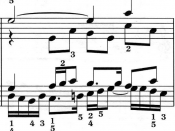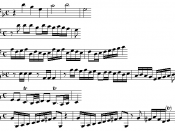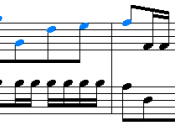Fugue
In music, a fugue (/fjuÃÂá/ fewg) is a contrapuntal compositional technique in two or more voices, built on a subject (theme) that is introduced at the beginning in imitation (repetition at different pitches) and recurs frequently in the course of the composition.
The English term fugue originated in the 16th century and is derived from the French word fugue or the Italian fuga. This in turn comes from Latin, also fuga, which is itself related to both fugere ("to flee") and fugare ("to chase").The adjectival form is fugal.Variants include fughetta (literally, "a small fugue") and fugato (a passage in fugal style within another work that is not a fugue).
A fugue usually has three sections: an exposition, a development, and a recapitulation containing the return of the subject in the fugue's tonic key, though not all fugues have a recapitulation. In the Middle Ages, the term was widely used to denote any works in canonic style; by the Renaissance, it had come to denote specifically imitative works.
Since the 17th century,the term fugue has described what is commonly regarded as the most fully developed procedure of imitative counterpoint.
Most fugues open with a short main theme, the subject,which then sounds successively in each voice (after the first voice is finished stating the subject, a second voice repeats the subject at a different pitch, and other voices repeat in the same way); when each voice has entered, the exposition is complete. This is often followed by a connecting passage, or episode, developed from previously heard material; further "entries" of the subject then are heard in related keys. Episodes (if applicable) and entries are usually alternated until the "final entry" of the subject, by which point the music has returned to the opening key, or tonic, which is often followed...


